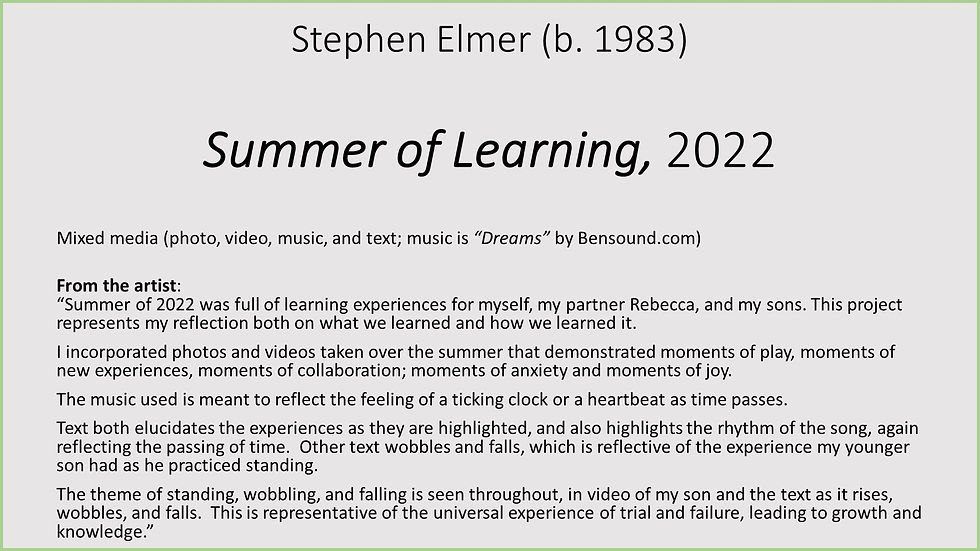Constructive Constructionism
- elmerst2
- Jul 10, 2022
- 3 min read
Updated: Aug 18, 2022
I am currently studying the educational theories of constructivism and constructionism (you can read more about these theories here). I am reflecting on how my place of practice acknowledges, fosters, and promotes (or does not) the principles of these theories.
As an exercise to promote further self-reflection, I put together an infographic describing my relationship with these theories, as well as my approach toward failure and ways that I try to incorporate innovation in my work. You can see that infographic below.

I work in a medical school as an instructional designer. I work primarily with faculty related to producing recorded lectures, reviewing the accessibility of course content, and developing learning activities. One of the things I have noted in my work is that faculty often seem to build their materials within the confines of traditional lecture formats. Though materials are digitized and made accessible via different methods (such as closed captioning, screen reader-friendly formatting, etc.), they rarely look to build learning experiences beyond traditional teaching style.
Among college administration, I do believe there is interest in moving beyond the typical “sage on the stage” format. However, one of the hurdles to this is a high value placed on the “academic freedom” of faculty, and because this freedom is given priority, many faculty tend to teach in the methodology they are most familiar with (again, standard lecture). Additionally, because many faculty are also clinicians (doctors working in hospitals or private practices), time for innovation and creativity is often unavailable. And finally, from the student perspective, students often indicate that they are overwhelmed with the amount of information they must assimilate, and so they are continually asking instructors to provide them with the “essential information” to help them pass certification exams. And so, precedence is given to information transfer versus learning.
Let me include one further personal observation of the current state of medical education that I see as a hurdle to incorporating constructivist methodology. To many students and faculty, failure is a four-letter word. For students who have “made it” to medical school, failure is incongruous with the career track that they’re on, and to introduce the expectation of failure as a step to learning would be met with anxiety and anger. Even for faculty, it is difficult to build learning activities that allow space for “wrong” answers. I am still exploring this phenomenon and looking for ways to help both groups understand the value of failure (and iteration) in the learning experience.
On another note, I do work with some faculty who are exploring teaching methods that reflect elements of constructivist theory. One example is the use of a faux electronic medical record (EMR) which students would initially view individually, with the task of theorizing diagnoses and formulating follow-up questions to ask the imaginary patient. This would then be followed with a group session where students work collaboratively with an instructor to review the patient case and consider alternate variables that might modify their initial diagnosis.
Unfortunately, I have not worked with any faculty who are attempting to implement constructionist theory in the curriculum. However, after reading articles exploring what constructivism is, as well as common misconceptions of its implementation and examples of successful implementation, I am inspired to explore possible opportunities to incorporate constructionism in the college's medical curriculum. As an example, one opportunity might be to augment the activity described in the previous paragraph: could we ask students who have completed said activity to, in groups, build their own imaginary patient cases. Further broadening the space for creativity, students could be given opportunity to reorganize the EMR structure and asked to provide justification for these changes. Finally, students could be asked to share their creations with their colleagues for feedback, discussion, and further iteration.
Ultimately, I find the constructivist and constructionist theories to be full of merit, and though they may be difficult to build into the current structure of my college’s curriculum, I will be spending the next few weeks (months? Years?) exploring ways to incorporate these concepts into the development of competent, compassionate doctors.
References:
Ackermann, E. (2001). Piaget's constructivism, Papert's constructionism: What's the difference. Future of Learning Group Publication, 5(3), 1-11. http://www.sylviastipich.com/wp-content/uploads/2015/04/Coursera-Piaget-_-Papert.pdf
Cohen, J. D., Jones, W. M., & Smith, S. (2018). Preservice and early career teachers' preconceptions and misconceptions about making in education. Journal of Digital Learning in Teacher Education, 34(1), 31-42. https://doi.org/10.1080/21532974.2017.1387832
Rob, M., & Rob, F. (2018). Dilemma between constructivism and constructionism: Leading to the development of a teaching-learning framework for student engagement and learning. Journal of International Education in Business, 11(2), 273-290. https://doi.org/10.1108/JIEB-01-2018-0002





Comments